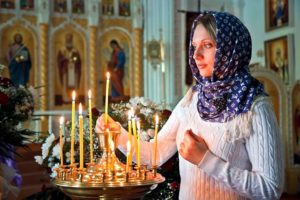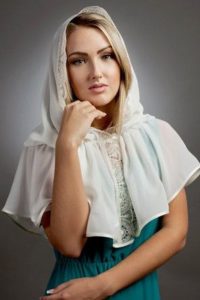 Visiting a temple requires appropriate preparation from a woman. Particular attention should be paid to the headdress. After all, a woman should not enter Orthodox churches with her head naked. This problem can be solved in different ways. An ordinary scarf, scarf, stole - this is what many people use. But church scarves, which are also called Don, wedding or Easter scarves, are becoming increasingly common.
Visiting a temple requires appropriate preparation from a woman. Particular attention should be paid to the headdress. After all, a woman should not enter Orthodox churches with her head naked. This problem can be solved in different ways. An ordinary scarf, scarf, stole - this is what many people use. But church scarves, which are also called Don, wedding or Easter scarves, are becoming increasingly common.
We will tell you about the uniqueness of this product, as well as how to sew such a scarf with your own hands.
History of the church scarf

The tradition of covering our heads came to us from antiquity, and not only ancient times. The headband was a common accessory for both Viking and Slav wives of the pagan era. Greek and Roman women, like women of the East, did not wear scarves, but spacious bedspreads that hid their figures to the toes. Such clothing protected both from the scorching sun and from immodest glances. This is how the custom inherited by the church was established.
Reference: The first mention of a scarf is contained in ancient Egyptian manuscripts, describing a quadrangular piece of fabric covering the shoulders.
The Apostle Paul finally ordered Christian women to wear a head covering, and not only in church.
For a long time, married Christian women, Catholics and Orthodox, could not appear in public without a rather strict headdress, hiding not only their hair, but also their forehead and neck. Girls were often freer in this matter, but not on the church grounds: they did not go there with their heads uncovered. They don't go now.
Traditionally, parishioners wear headscarves, although there are no clear regulations regarding headwear. It's a matter of taste. In the case of a church scarf, it is often very elegant. After all, a woman’s head covered with thin (often lace) fabric looks touching and exciting! And without any violations of the rules of piety. Especially if we are talking about the Don scarf, which resembles a hood.
The history of its appearance has not even celebrated its tenth anniversary, having begun in 2010 on the Don.
Reference. The flowing scarf was created by Irina Potapova, a woman in whose life, thanks to her diligent prayers, a small miracle happened. She became a mother, contrary to the pessimistic predictions of doctors.
Preparing for Epiphany, she sought to create a joyful and bright festive atmosphere. This is how a real design miracle appeared - you can be elegant without violating the rules of piety!
What kind of scarf should you wear when visiting a temple?

First of all, there must be at least one scarf. This is enough to visit the temple. But female nature does not tolerate asceticism. And the church does not prescribe that one should refuse to wear clothes if they do not violate the rules of chastity.
Symbolizing female obedience, the head cover can decorate a parishioner. Especially on holidays! The wardrobe of a temple visitor has several options for headscarves.
Much depends on the frequency of being within church walls. Visitors rarely need the minimum set. For the holidays, a light (or white) headdress, plain or with a discreet ornament, is suitable. Fasting or mourning will require dark colors.
Pay attention to the pattern of the flowing scarf! Depictions of symbols of other religions, specific ornaments like hemp leaves, provocative inscriptions are inappropriate in a holy place.
Truly church-going women quickly learn to understand the color and design nuances of clothing for the church. The main principle is simple - clothes should be comfortable. This also applies to the scarf: it should not distract during the service by unraveling and falling off the head.
The Don scarf seems to be the best option: it does not fall off thanks to the ties, does not require constant re-tying of the ends, and covers the shoulders.
How to sew a church scarf with your own hands
This airy beauty does not require the qualifications of a seamstress. You can sew a scarf for the church yourself.
Don scarf pattern
The universal pattern is made according to the pattern shown in the photo.

- Fold a sheet of paper 110 cm long and 70 cm wide in half so that the fold runs along the width.
- We turn the resulting rectangle towards ourselves so that the fold is at the top. This will be the back of the head, the face will be on the left.
- From the upper left corner we measure 50 cm along the fold line, 40 cm along the left side and mark.
- We connect two points with a rounded line, using a pattern or by eye - here we will have a drawstring.
- Draw the same line from the lower left to the upper right corner. This will be the bottom edge of the product. We cut off the excess along it.
Pattern sizes are adjusted to suit individual needs! Especially if the scarf is sewn for a child.
How to calculate the amount of fabric
By purchasing a meter of fabric 140–150 cm wide, you will receive one scarf and a strip of fabric 30 cm wide.
And from a 120 cm cut two scarves will come out for the temple; you can cut them in both length and width!
The product is quite simple to make, but it makes sense to first practice with a piece of unnecessary fabric. Do you suddenly want to experiment with length?
Choosing fabric for a church scarf

Will fit festive, light, openwork fabrics: guipure and silk, organza and lace. Their density can be different - we take into account the case, age, financial capabilities. The product can be very expensive or budget, strict and delicate.
Important! Transparent fabrics are only appropriate for weddings.
Particular attention is paid to color. You can remain a “correct” parishioner if you have a wardrobe that is rich in color! You just need to understand the peculiarities of color liturgical traditions.
- White associated primarily with the image of the bride. But the main meaning of the white color, which combines the entire spectrum, is to symbolize the miraculous light of God. This is the color of Christmas and Epiphany, Ascension and Transfiguration, the beginning of the Easter service. Also appropriate for the sacrament of Baptism.
- Complete opposite - black. Repentance, fasting, mourning, renunciation of temptations the world are the reason for the black cover. Can be replaced with dark brown. Quite appropriate on an ordinary day when there is no holiday.
- Church scarf maybe red from Easter to Ascension, and yellow on days of special veneration of God’s anointed, and green on Trinity, and heavenly flowers (on the days of veneration of the Mother of God).Multi-colored scarves can create the necessary atmosphere of any religious event in the soul of a parishioner and in the church, as long as the principle of appropriateness is not violated.
We sew a church scarf
Step-by-step instructions will tell you the correct sequence of actions.
Preparing for work
- Having secured the above knowledge, choosing the material for sewing the product and finishing it. We will need 2 m of bias tape, 3.5 m of lace, one and a half meters of satin ribbon or decorative cord, two ends - all to match the fabric.
- Preparing the workplace. You will need a fairly large surface for cutting, a centimeter, scissors, thread, and pins.
Uncover

- Carefully trim the edge of the fabric.
- To get a symmetrical piece of material, carefully fold it diagonally at a right angle. If there is an extra strip of fabric on one side, cut it off.
- Above we discussed the consumption of fabric and the advisability of choosing a cut of 120 cm. If it was made, divide the cut into two. To do this, first fold the fabric in half lengthwise and cut it. You should get two rectangles with sides of 120 and a width of 70-75 cm (with a fabric width of 140-150 cm).
- We put one piece aside until next time, and work on the other.
- Fold it in half with the wrong side out, and align it well.. Carefully ironing the fabric on the fold will help with this so that it does not break. Place the fabric so that the fold is at the top.
- Following all the rules for ironing delicate fabrics, we check the cleanliness of the soleplate of the iron, hands and the fabric itself! Carelessness can ruin an item before it is ready.
- Let's start cutting. We can use the pattern described above. All the elements of the future scarf are marked on it.It is possible to do without a pattern, having completed all the steps necessary to create it on the fabric.
- Attach the pattern to the folded fabric. We apply the upper left corner of the pattern to the upper left corner of the fabric, the fold lines and the left side of the pattern and fabric coincide.
- We pin it together and trace it along the lower rounded part of the pattern (the edge of the product). Cut both layers of fabric along the marked line.
- Cut off part of the pattern along the drawstring line. We remove the lower part and fix the remaining part again on the fabric.
Manufacturing

- We lay the drawstring along the laid lineAnd. We start from the point measured on the left edge of the fabric, where we use a pin to secure the bias tape with the whole side facing up.
- Then we apply the binding in the same way, moving along the entire rounded line to the point measured on the fold of the fabric. We prick the pins with the point up, since we will need to repeat the entire procedure on the other side of the fabric. Make sure again that the front part of the fabric is inside! We work from the inside out!
- Turning the fabric over, we lay the drawstring further, focusing on the already prepared side. The stripes must match! We cut the binding so that there is a margin of a centimeter from the edge of the fabric.
- We attach the drawstring on the machine on both sides, having previously folded its edges so that a strip of fabric of a couple of millimeters remains above the edge - this will be useful when finishing the edge.
Finishing

- The lace is sewn from the front part with a small zigzag. The work can be done in two ways. Or we cut it at the corners and overlap it. Or we gently bend the corners with a single strip of lace, passing from one edge of the drawstring to the other. The main thing is not to sew up the holes for the ties.
- We are preparing a ribbon, decorative cord, etc.We use end caps or decorative beads at the edges and thread them into the drawstring. An elastic band and a beautiful button at the bottom of the hood are possible).
How to wear a Don scarf correctly
Tailored especially for going to church, The scarf should cover the head and shoulders, falling slightly onto the forehead and cheeks.
If it is properly sewn and worn accordingly, it covers its wearer. A scarf that is kept haphazardly on the top of the head does not comply with the rules.
Having left the temple, you can freely place the upper part of the scarf over your shoulders, as if with a folded hood. This will give the look elegance and sophistication.


 0
0






what about the size? Is head size not important? The thing is that I have a hairpiece. Will I fit into this scarf?
Of course you can get in! He turns out to be free.